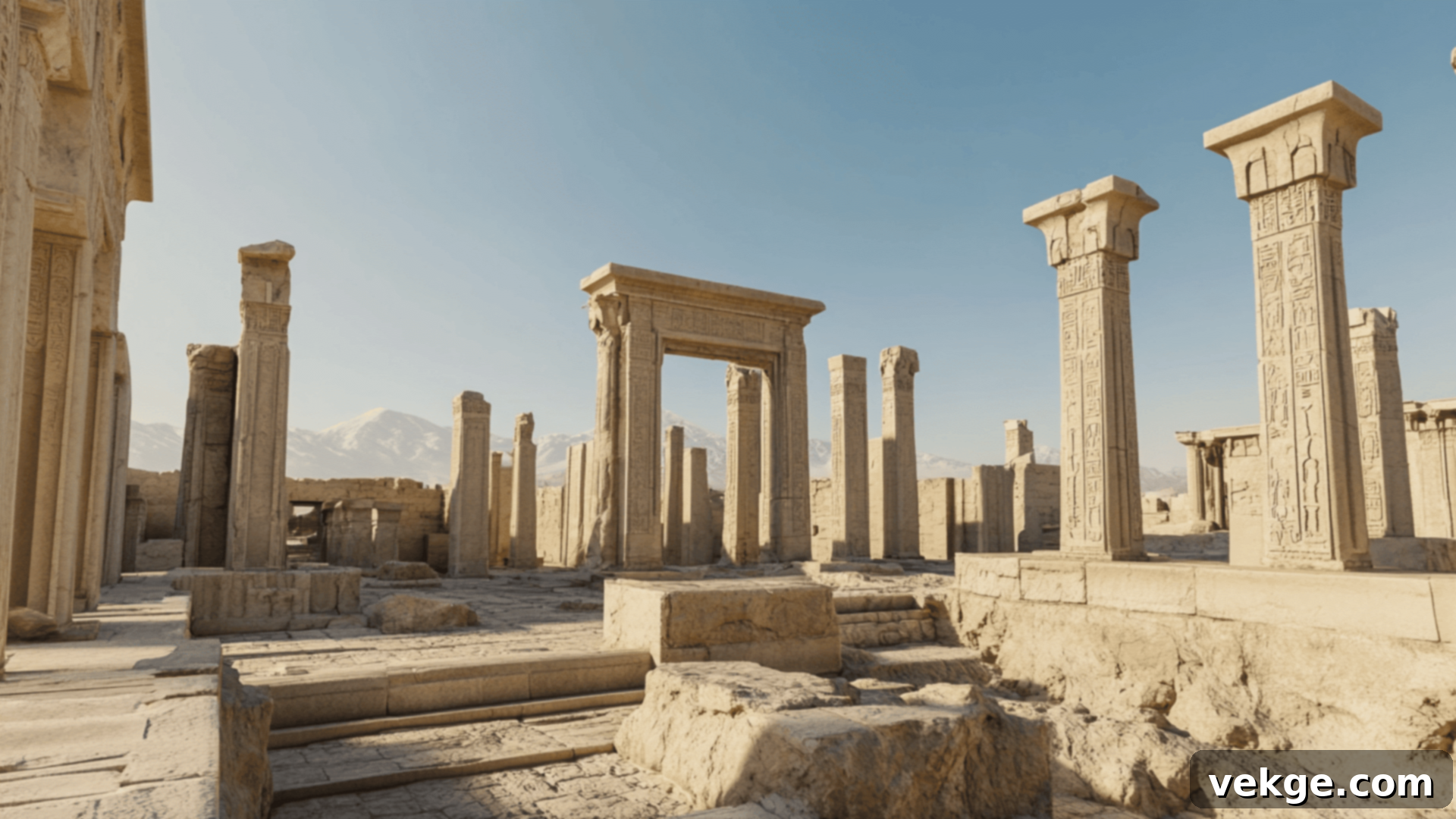The Enduring Legacy of Persian Architecture: A Journey Through Time and Design
Persian architecture boasts a rich and profound history, spanning thousands of years and leaving an indelible mark on global design. From the majestic palaces of ancient empires to the intricate mosques of later dynasties, it has consistently showcased a unique blend of structural innovation, symbolic artistry, and profound cultural expression. This architectural tradition played a pivotal role in shaping the cities, temples, and royal residences across the vast Persian Empire, influencing cultures far beyond its borders.
Through various periods, including the Achaemenid, Sassanian, and Safavid eras, Persian buildings were meticulously crafted to embody and project the empire’s immense power, unparalleled beauty, and sophisticated culture. Architects and artisans masterfully employed distinctive elements such as symmetrical layouts, detailed tilework, and advanced building techniques that were centuries ahead of their time. These designs are not merely historical relics; they continue to inspire contemporary architecture, demonstrating a timeless appeal and enduring relevance.
In this comprehensive guide, we will delve into the core characteristics that define Persian architecture, explore some of its most iconic structures, and examine how these profound designs permeated and influenced other cultures, cementing Persia’s place as an architectural giant.
Key Characteristics of Persian Architecture
Persian architecture is renowned for its distinctive features that combine aesthetics with deep symbolic meaning and practical ingenuity. These characteristics collectively form a style that is both grand and harmonious.
Symbolic Geometry
At the heart of Persian architectural design lies a profound appreciation for geometric shapes. Squares, circles, and octagons are not merely decorative elements but carry deeper philosophical and cosmological meanings. The meticulous use of these forms symbolizes harmony, order, and the divine structure of the universe, integrating beauty with purpose in every building. For instance, the transition from a square base to a circular dome through squinches or muqarnas symbolizes the journey from the earthly realm to the celestial, creating a sense of spiritual elevation within the space. Complex tessellations and intricate patterns derived from these fundamental shapes cover surfaces, creating a mesmerizing visual rhythm that reflects an underlying mathematical precision and philosophical worldview.
Symmetry and Balance
A cornerstone of Persian design, symmetry and balance are particularly evident in grand palaces, mosques, and gardens. Symmetrical layouts are employed to convey a powerful sense of harmony, control, and stability. The careful placement of rooms, courtyards, and structural elements ensures a visual equilibrium that is both aesthetically pleasing and structurally sound. Axial symmetry, where a central axis divides a structure into two mirrored halves, creates a sense of grandeur and order, reflecting the organized and powerful nature of the empire itself. This balance was a crucial feature, designed not only for beauty but also to project authority and an underlying sense of cosmic order.
Material Usage
Persian builders expertly utilized locally available materials, primarily stone, brick, and an array of vibrant tiles. These materials were selected for their inherent strength, durability, and aesthetic potential. Stone was a favored material for monumental structures like Persepolis, chosen for its longevity and ability to convey grandeur. Brick, on the other hand, became prevalent in later periods, particularly for its versatility in creating intricate vaulted ceilings and domes. The use of colorful, glazed tiles, however, is arguably the most iconic material application. These tiles, often in shades of turquoise, cobalt blue, white, and gold, were used to create stunning patterns and calligraphic inscriptions that transformed building facades and interiors into luminous, artistic masterpieces. This meticulous attention to both structural integrity and decorative appeal resulted in timeless structures that continue to captivate.
Decorative Elements
Persian architecture is celebrated worldwide for its extraordinarily detailed and rich decorations. Tilework, mosaics, and muqarnas (a form of corbelled vaulting, often described as ‘stalactite’ or ‘honeycomb’ vaults) are ubiquitous in palaces, mosques, and madrasas. Tilework varies from simple glazed bricks to complex haft-rangi (seven-color) or cuerda seca techniques, depicting geometric patterns, arabesques, floral motifs, and calligraphic scripts that convey religious texts or poetic verses. Muqarnas not only serve as a structural element to transition between different architectural forms but also create breathtaking three-dimensional decorative elements in entrances, domes, and iwans. These intricate details are not merely superficial; they add profound beauty, uniqueness, and spiritual depth to the buildings, showcasing the unparalleled skill and artistic ingenuity of Persian builders and designers.
Notable Examples of Persian Architecture
Persian architectural brilliance is best understood through its magnificent surviving structures, each telling a story of its era and contributing to a rich historical tapestry.
Persepolis

Persepolis, the ceremonial capital of the Achaemenid Empire, stands as a monumental testament to ancient Persian grandeur. Known for its awe-inspiring palaces and impressive structures, including the vast Apadana Hall and the Gate of All Nations, it served as a grand stage for royal receptions and festivities. The city’s construction, initiated by Darius the Great around 515 BCE, features colossal stone columns, grand staircases adorned with detailed relief carvings depicting tributary nations, and massive halls designed to impress visitors. These carvings not only served as decoration but also illustrated the empire’s vastness and the diversity of its people, showcasing its immense power and sophisticated artistic skill.
Golestan Palace

Located in the heart of Tehran, Golestan Palace is a resplendent royal complex from the Qajar era that beautifully illustrates the evolution of Persian design. It uniquely blends traditional Persian aesthetics with emerging European influences, particularly evident in its later additions. The palace features stunning Persian gardens (charbagh), ornate halls like the Mirror Hall, and rooms adorned with vibrant, intricate tilework and delicate stucco. Its elegant architecture and lavish interiors reflect a period of artistic cross-pollination, showing how Persian architecture adapted over time while steadfastly preserving its deep cultural roots and commitment to decorative artistry. Golestan Palace is a UNESCO World Heritage site, celebrated for its artistic and architectural significance.
Sheikh Lotfollah Mosque
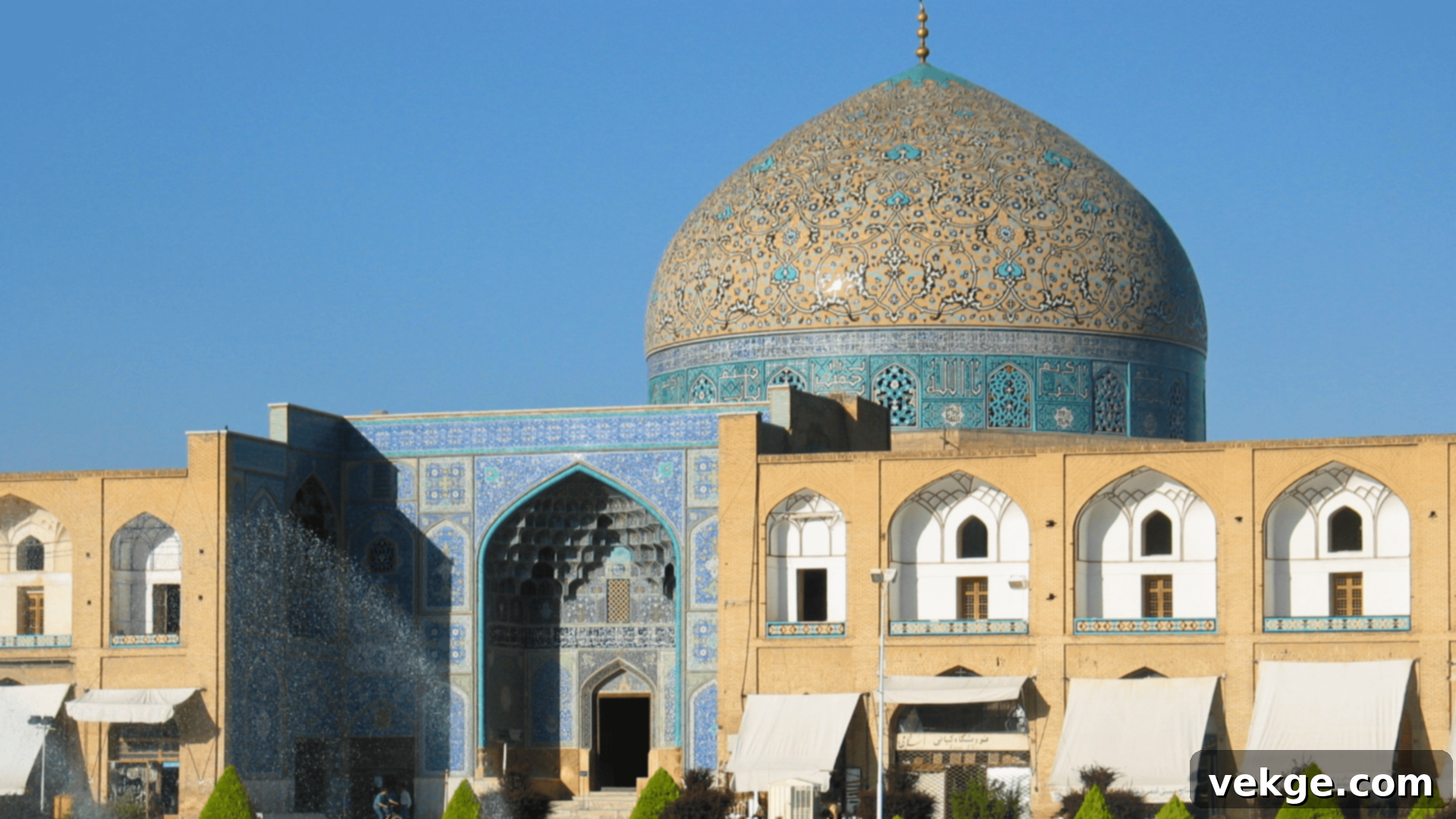
A true masterpiece of the Safavid era, Sheikh Lotfollah Mosque in Isfahan is famed for its breathtakingly intricate tilework and its unique, minaret-less dome. Built as a private mosque for the royal court, its design is distinct from public mosques, focusing on unparalleled internal decoration and a sense of serene intimacy. The dome, with its mesmerizing light-colored tiles that subtly change hue throughout the day, features spiraling arabesques that converge at a central peacock motif – a true marvel of optical illusion and craftsmanship. The mosque’s design stands as a pinnacle of Safavid artistic and architectural achievement, with its intricate patterns and harmonious colors continuing to be admired for their beauty, spiritual depth, and technical skill.
Ali Qapu Palace
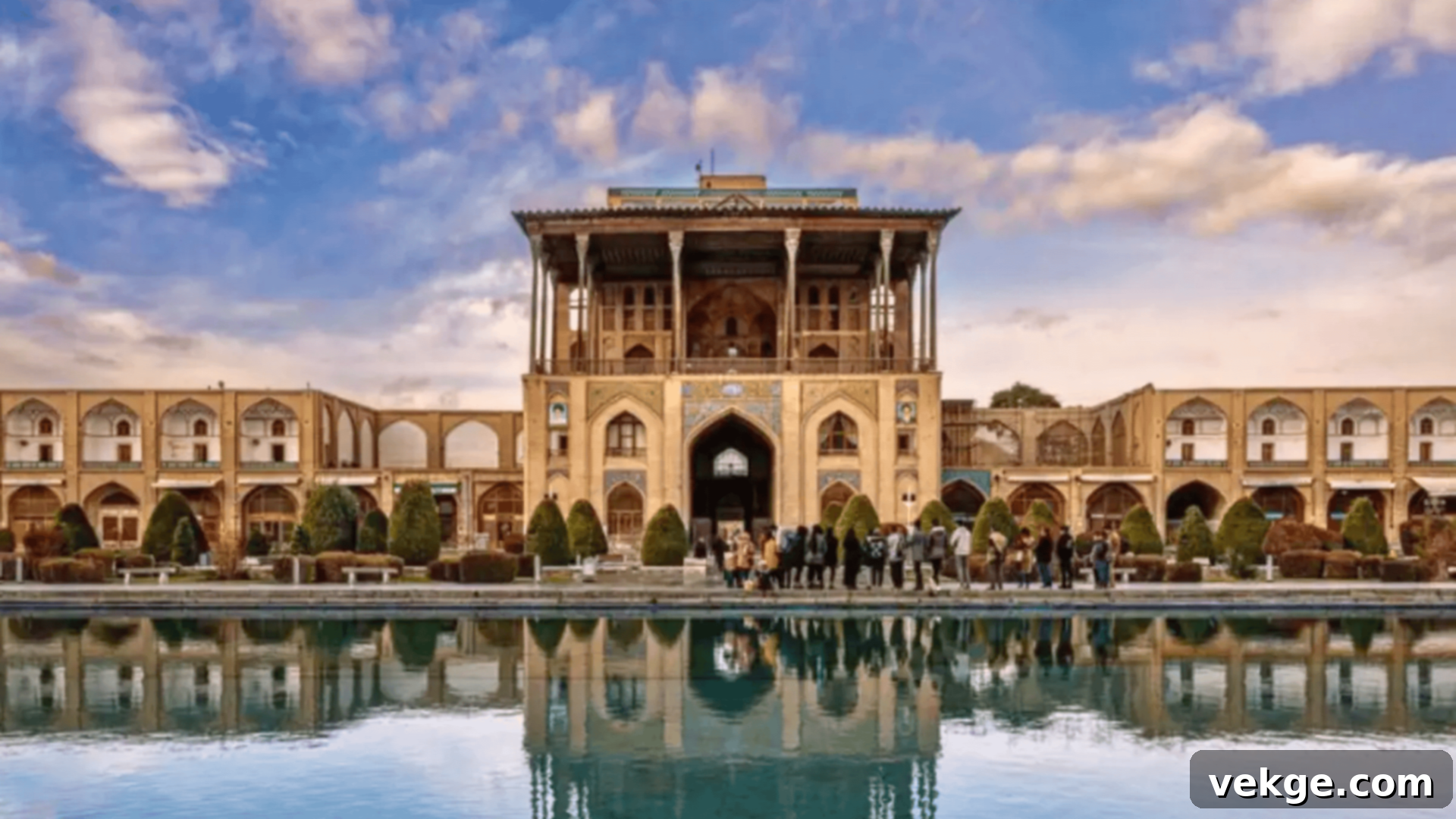
Ali Qapu Palace, meaning “Grand Gate,” was built as a majestic royal residence and serves as the monumental entrance to the royal quarter on Naqsh-e Jahan Square. Its most striking feature is the grand reception hall, characterized by its lofty ceilings, a stunning elevated terrace offering panoramic views of the square, and intricately detailed paintings and frescoes that adorn its walls and ceilings. The palace’s design profoundly highlights the Persian emphasis on both aesthetic beauty and political grandeur, serving as a venue for royal gatherings, diplomatic receptions, and musical performances in its acoustically designed music room. It remains an iconic symbol of Safavid history and architectural ingenuity, embodying royal power and cultural sophistication.
Jame’ Mosque of Isfahan
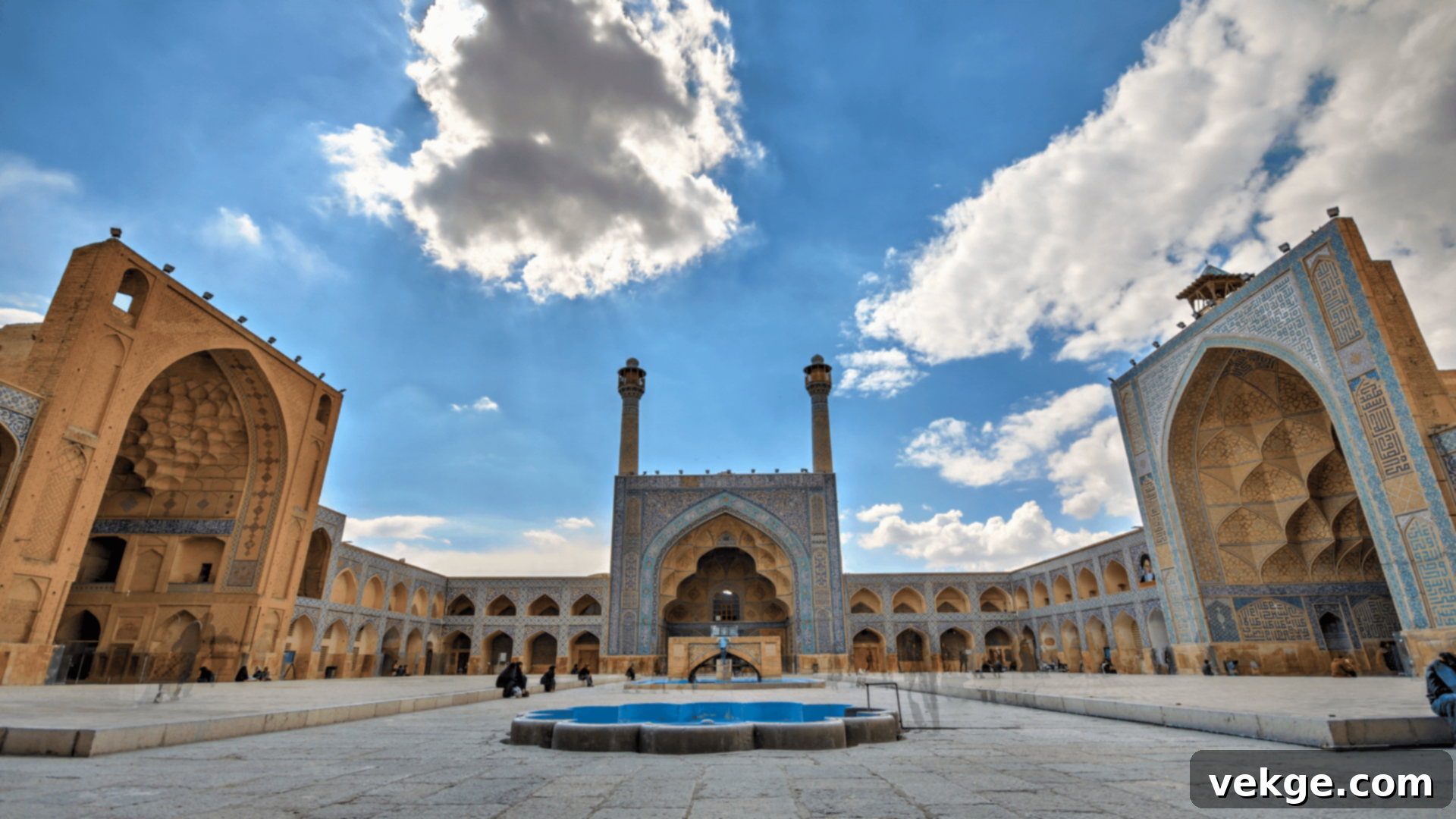
The Jame’ Mosque of Isfahan (Masjed-e Jāmé of Isfahān) is an extraordinary architectural complex, showcasing the continuous evolution of Persian mosque design over more than a millennium. Built and expanded over many centuries, it integrates elements from various periods, including early Islamic, Seljuk, Ilkhanid, and Safavid additions, making it a living museum of Persian architectural styles. Its iconic four-iwan plan, two domed chambers, and vast courtyards reflect successive innovations and adaptations, offering a unique opportunity to study the development of religious architecture. It stands as one of the most significant and iconic religious buildings in Iran, profoundly demonstrating the depth, richness, and adaptability of Persian architectural design across different epochs.
Naqsh-e Jahan Square
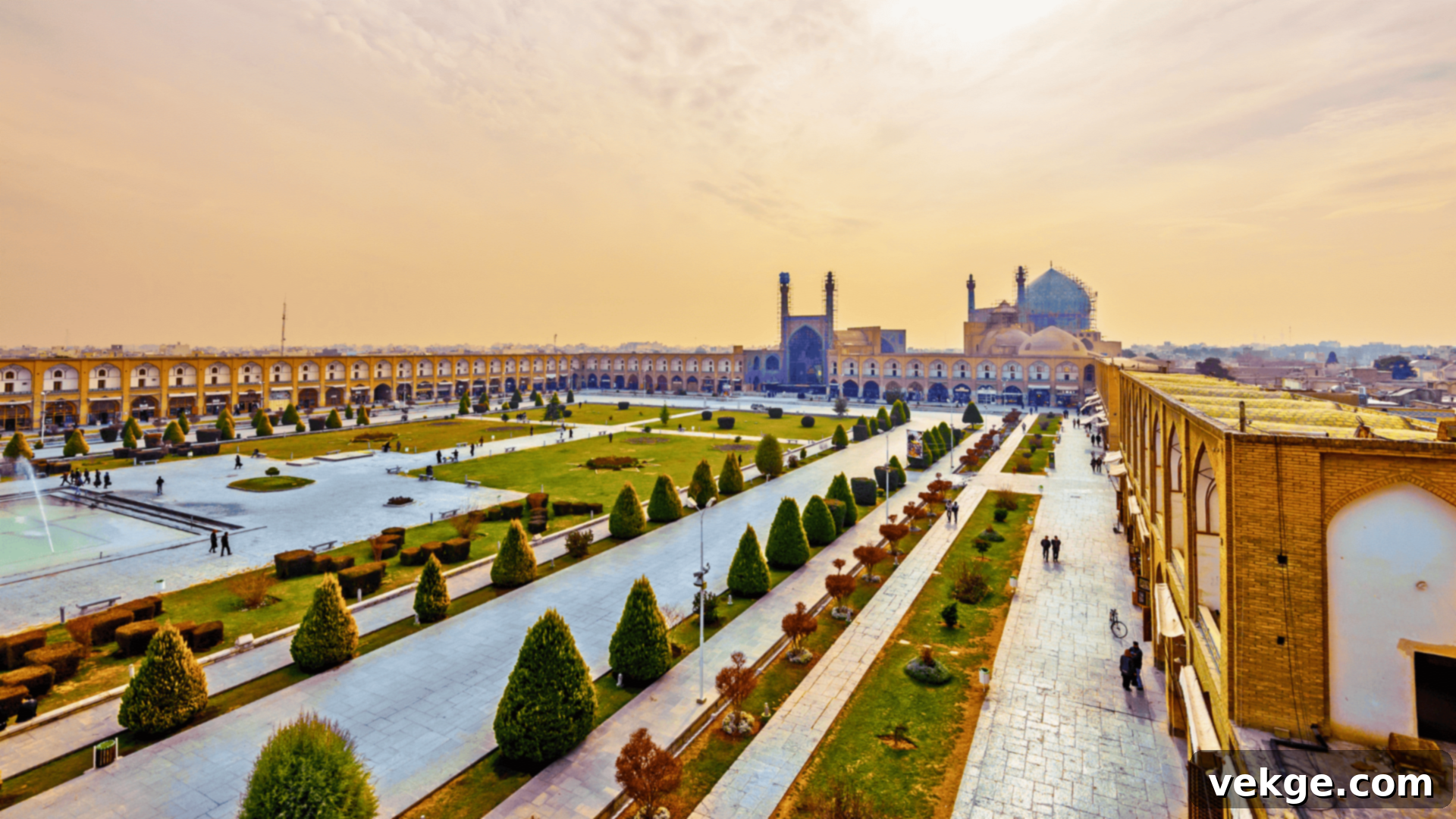
Naqsh-e Jahan Square, located in Isfahan, is a UNESCO World Heritage site and a breathtaking example of Safavid urban planning and architectural integration. This immense square, one of the largest in the world, is encircled by an array of magnificent buildings: the Imam Mosque (Shah Mosque), Sheikh Lotfollah Mosque, Ali Qapu Palace, and the Qeysarie Gate leading to the Grand Bazaar. Its carefully planned layout and design embody the zenith of Persian architectural and urban planning achievements, functioning as a vibrant hub for religious, commercial, and political activities. The square continues to be a crucial cultural and historical landmark in Iran, attracting visitors worldwide to marvel at its harmonious blend of monumental scale and intricate detail.
Religious and Political Influences on Architecture
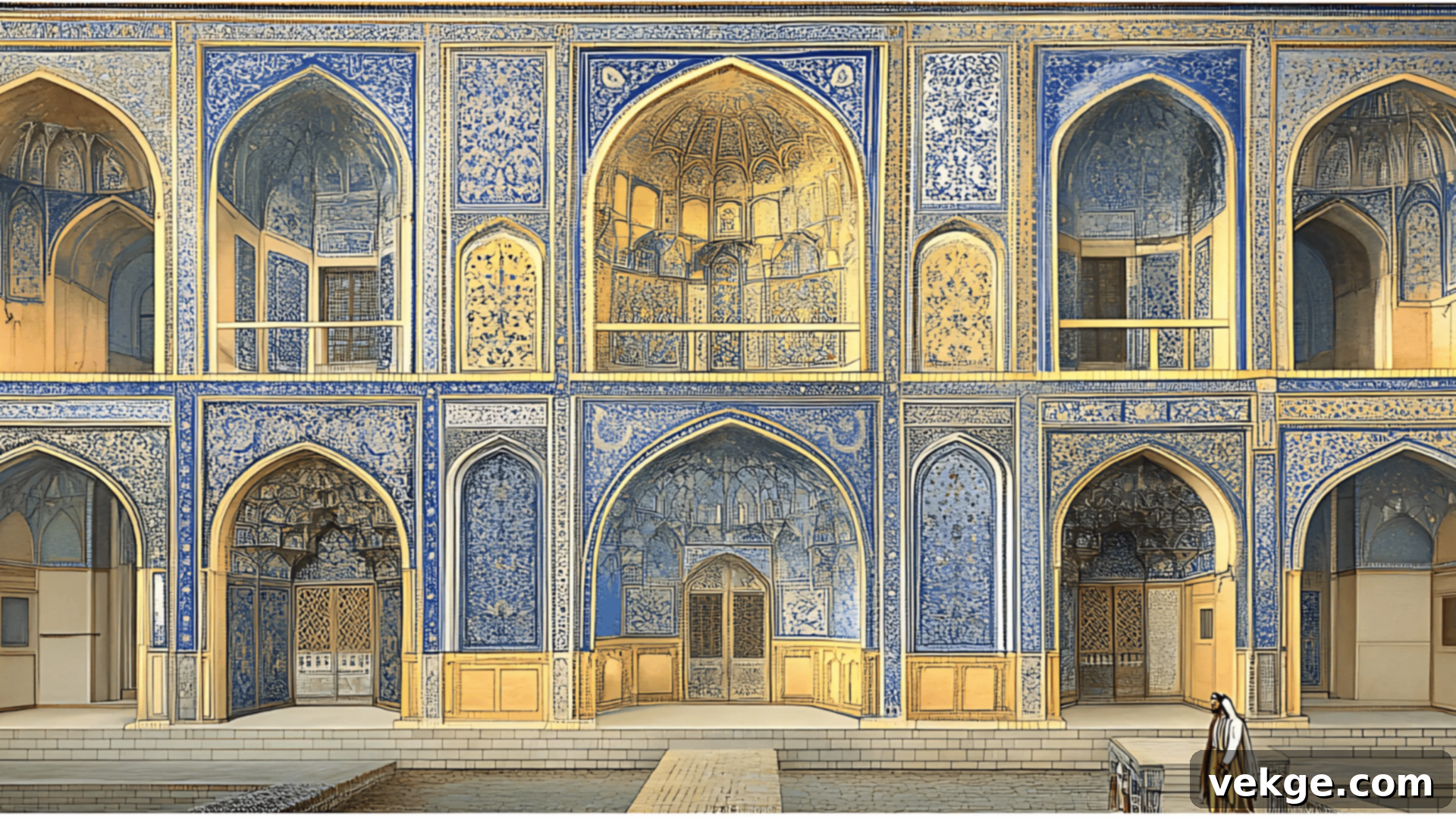
Persian architecture has always been deeply intertwined with the religious beliefs and political ambitions of its ruling powers, manifesting these influences in both form and function.
Zoroastrianism
Before the advent of Islam, Persian architecture was profoundly shaped by Zoroastrianism, the state religion of empires like the Achaemenids and Sassanians. Fire temples, often characterized by their chahartaq (four arches supporting a dome) structures, were built to venerate Ahura Mazda and house sacred fires, which were central to Zoroastrian worship. Royal palaces and monumental structures were designed not only to honor the gods but also to reflect the divine mandate and immense power of the rulers. These buildings often featured large, open spaces, grand entrances, and were strategically oriented to connect the earthly realm with the divine, laying foundational architectural concepts that would later be adapted by Islamic builders, such as the dome on squinches and the use of monumental scale.
Islamic Influence
With the arrival and spread of Islam in the 7th century, Persian architecture underwent a significant transformation, evolving to incorporate and adapt Islamic elements while retaining its distinct identity. Key Islamic architectural features such as domes, towering minarets, intricate mihrabs (prayer niches), minbars (pulpits), and the extensive use of calligraphic tilework became integral to Persian designs. The Safavid period, in particular, witnessed a spectacular efflorescence of grand mosques, madrasas, and religious complexes. These structures masterfully fused traditional Persian design principles, like the four-iwan plan and courtyard layouts, with Islamic artistic expressions, creating a unique and highly influential style that spread throughout the Muslim world and beyond.
Political Symbolism
Persian rulers throughout history artfully utilized architecture as a powerful tool to legitimize and convey their authority, status, and imperial might. Grand palaces, administrative centers, and even entire city layouts, such as those found in Persepolis or Isfahan’s Naqsh-e Jahan Square, were meticulously designed to awe and impress, reflecting the strength and organizational prowess of the empire. Monumental structures were not merely functional; they served as tangible statements of a ruler’s wealth, control, and vision. The sheer scale, durability of materials, and artistic splendor of these buildings symbolized the greatness of the empire, with each architectural achievement acting as a profound declaration of political power and cultural supremacy.
Persian Architecture’s Influence on Other Cultures

The aesthetic and structural innovations of Persian architecture did not remain confined within its borders; they profoundly shaped architectural traditions across vast geographical regions, demonstrating a remarkable cultural exchange.
Cultural Exchange
Persian architectural styles exerted a lasting and significant impact on neighboring regions, including Central Asia, the Middle East, the Indian subcontinent, and even parts of Europe. As the Persian Empire expanded and through extensive trade routes like the Silk Road, the influence of its sophisticated designs spread far and wide. Many of these regions adopted and adapted Persian architectural elements such as the pointed arch, the iconic iwan, distinctive column designs, the use of grand courtyards, and sophisticated decorative tilework. This vibrant exchange of ideas led to a rich blending of styles, which in turn enriched and diversified the architectural traditions of numerous cultures, creating new forms that bore the unmistakable stamp of Persian genius.
Architectural Adaptations
The legacy of Persian architectural elements is particularly evident in later empires, most notably the Mughal Empire in India. Mughal rulers, who had strong cultural ties to Persia, greatly admired and consciously incorporated Persian design principles into their own monumental palaces, forts, and mosques. Iconic structures like the Taj Mahal, Humayun’s Tomb, and Fatehpur Sikri all exhibit clear Persian influences in their use of perfectly symmetrical layouts (charbagh gardens), pointed arches, impressive iwans, intricate marble inlay, and exquisite tilework. Beyond India, Persian forms also impacted Ottoman architecture (especially in ceramics and dome structures) and influenced parts of the Byzantine and even Roman architectural traditions. These widespread adaptations allowed Persian architectural ideas to proliferate and profoundly shape the design of structures across vastly different cultures and historical periods, cementing its universal appeal and enduring significance.
Modern Interpretations of Persian Architecture
Today, the timeless principles and captivating elements of Persian architecture are experiencing a vibrant revival, as contemporary architects creatively integrate traditional features into modern designs, ensuring that this rich heritage continues to thrive and evolve.
Contemporary Revival
In recent years, there has been a significant resurgence of interest in Persian architectural elements within modern building designs, particularly across the Middle East and other Islamic countries, but also globally. Architects are skillfully reinterpreting classic Persian motifs and structures, such as grand arches, majestic domes, intricate muqarnas, and elaborate tilework, to create innovative structures that seamlessly blend the old with the new. These contemporary buildings often marry cutting-edge modern technology and sustainable practices with ancient techniques and aesthetic principles, resulting in stunning designs that honor Persian heritage while effectively meeting contemporary functional and environmental needs. This revival demonstrates the enduring versatility and beauty of Persian architectural language.
Adapting Ancient Techniques
Many of the ingenious techniques employed in ancient Persian architecture remain remarkably relevant in today’s construction landscape. Modern builders and designers are adapting traditional uses of local materials like stone, brick, and specialized tiles to construct buildings that are not only aesthetically striking but also durable, energy-efficient, and culturally resonant. The ancient methods of constructing vast domes and elegant arches, often without extensive modern scaffolding, are being studied and re-applied in contemporary structures, sometimes with modern materials and structural analyses. This thoughtful integration of historical wisdom with modern advancements ensures that Persian architectural traditions remain vibrant and adaptable, proving their timeless value in addressing the demands of modern construction and design.
The Role of Persian Architecture in Urban Planning
Beyond individual structures, Persian architecture played a crucial role in shaping comprehensive urban planning, emphasizing well-organized city layouts and a harmonious integration with the natural environment. These designs were not merely functional; they reflected the empire’s power, its focus on harmony, and a deep understanding of human needs and environmental considerations.
City Layouts and Infrastructure
Ancient Persian cities, such as Persepolis, Ctesiphon, and later Isfahan, were models of meticulous urban planning. Their layouts typically featured wide, ceremonial roads, grand open plazas (like Naqsh-e Jahan Square), and bustling marketplaces (bazaars) that served as centers for trade and social interaction. Each component of the city was strategically organized to ensure efficient movement, easy access to important civic and religious buildings, and logical integration of residential zones. Advanced infrastructure, including sophisticated qanats (underground aqueducts) for water supply and caravanserai for travelers, was seamlessly incorporated. This careful, top-down planning reflected the organizational power and centralized control of the Persian Empire, creating functional and aesthetically coherent urban fabrics.
Integration with Natural Environment
A defining characteristic of Persian urban planning and architecture was its profound respect for and integration with the natural environment. Mountains, rivers, and especially meticulously designed gardens (charbagh) were not merely external features but were intrinsically woven into the city layouts and individual architectural complexes. The design aimed to create a deep harmony between the built environment and nature, using water features, shade-providing trees, and natural ventilation systems to create comfortable microclimates. This sophisticated approach not only enhanced the beauty and liveability of Persian cities but also highlighted the early sustainable and environmentally conscious practices of the Persian Empire, demonstrating a nuanced understanding of climate and resources.
Persian Influence on Residential Architecture
Persian architectural principles have significantly influenced residential design, particularly through the development and widespread adoption of the courtyard house. This architectural style prioritizes privacy, comfort, and a profound connection to nature, shaping homes in countless cultures across the globe.
The Courtyard House
The Persian courtyard house stands as a quintessential residential design, characterized by its inward-looking layout built around a central, open-air courtyard. This ingenious design offers unparalleled privacy, creating a peaceful and secluded environment away from the bustling streets. The courtyard itself often features meticulously maintained gardens, soothing fountains, and shaded areas, serving as the heart of the home for family gatherings, leisure, and climate control. This practical and aesthetically pleasing design proved highly influential, becoming a popular residential model in many other cultures, especially throughout the Islamic world, due to its effectiveness in diverse climates and its ability to foster intimate family life.
Privacy and Comfort in Residential Design
Persian homes placed immense importance on both privacy and comfort, reflecting deep-seated cultural values. External walls were typically designed with minimal openings or high windows to block out external views, thereby creating a profound sense of safety, seclusion, and tranquility within the domestic space. Internally, rooms were often lavishly decorated with exquisite tiles, intricate plasterwork, and plush furnishings, adding layers of comfort and beauty to the living environment. Features like basements (sardab) and wind catchers (badgirs) were integrated to provide natural cooling, enhancing comfort during hot summers. The thoughtful design of these homes clearly reflected the Persian value of personal space, family life, and creating an oasis of calm amidst the external world.
Conclusion
The rich tapestry of Persian architecture, with its millennia-long history, stands as a beacon of human ingenuity, artistic prowess, and profound cultural expression. From the monumental scale of Achaemenid palaces to the intricate artistry of Safavid mosques and the ingenious design of traditional courtyard homes, it reflects an enduring pursuit of beauty, order, and functionality. The mastery of symbolic geometry, the emphasis on perfect symmetry, the innovative use of materials like colorful tiles, and thoughtful urban planning principles continue to inspire architects and designers worldwide today.
The influence of Persian design can be observed in buildings across continents, from the minarets of Central Asia to the grandeur of Mughal India, proving the timeless appeal, innovative spirit, and universal beauty of Persian architectural forms. Studying these architectural wonders offers not just an aesthetic appreciation but also a deep understanding of the rich history, philosophical underpinnings, and cultural traditions that shaped one of the world’s most influential and enduring civilizations.
If you enjoyed this comprehensive journey into Persian architecture, be sure to explore more of our articles for similar captivating content on architecture, design, and history!
